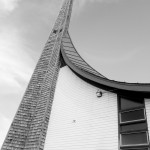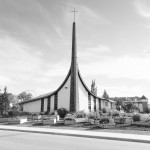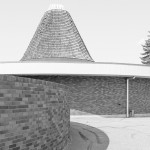The institution of the church is changing. The congregation at Ebenezer United Church in West Edmonton will be merging[1] with nearby St. Andrew’s United, the building having been sold to the Saint Virgin Mary Ethiopian Orthodox Tewahedo Church. Augustana Lutheran in Edmonton’s downtown core, brand new in 1954 to house a congregation established in 1930, will soon be demolished[2] to make way for a high rise condominium building. Both assemblies, like many others in our city, could not sustain themselves after years of dwindling and aging congregations, as the role of religion in the lives of many Canadians has changed remarkably in the past half century.
But at a different time in our history, many facilities had the opposite problem – neighbourhood churches simply couldn’t expand quickly enough to serve the burgeoning communities of our new suburbs. Built to serve the city’s exploding population in the period after WWII, the many neighbourhood churches constructed between approximately 1950 and 1970 – during the mid-century modern period – are some of Edmonton’s most unique older buildings, and remain sound examples of innovative architecture after five or six decades. These places are the source of many stories about the changing built environment, about changing belief, and most importantly, about the people that have spent their time within.
Architecturally, the Modernist period in the Canadian Prairies has been discussed very little; many prime examples remain in our city’s neighbourhoods, being somewhat hidden in plain view, almost in the background of our experience of the city. In our age of constant renovation and customization of properties with every new owner, these churches have somehow stayed largely the same over half a century. Whether due to fiscal constraints by their congregations – making repairs only as absolutely necessary – respect for the original structures, or inordinately successful initial design, many of these buildings are like time capsules from the mid-century period, and can provide a glimpse into the Edmonton of this time.
Amid the wealth and optimism following World War II and the discovery of oil at Leduc No. 1 in 1947, Edmonton experienced a major boom in urban development. This was the post-war period, and the era of Noel Dant, the first Head of Edmonton’s Planning Department, who initiated a huge number of new communities adhering to the novel concept of the “neighbourhood unit. He identified these as ” discrete communities, bounded by arterial roads, which presented a safe and walkable module for community living – in predominantly affordable, single-family bungalows.” The modified, discontinuous street grid central to Dant’s designs, aimed mainly at discouraging shortcutting traffic, also critiqued the early twentieth century’s uniform street grid “as sterile and unattractive as well as unresponsive to the existing topography of the land.[3]” A typical neighbourhood unit was focused around a central park space usually associated with a school or two, surrounded by a small number of residential apartments and townhouses, convenient neighbourhood businesses, sometimes a curling rink, usually one of Edmonton’s trademark community league buildings (a pioneering and still nearly unique concept in North American cities), and typically at least one church. As Dant’s new neighbourhoods proliferated in the city – approximately 40 were built in the 1950s alone – a consequential body of neighbourhood churches followed to serve their new residents.
This massive urban project paralleled a modernization in church doctrine at the time for many denominations, which included measures to make worship more democratic and accessible with greater involvement from the congregations. A new modern style of building dovetailed well with this movement, helping to foster a new type of Sunday gathering that was more about community, neighbourhood and participation in service to others than dogmatic views of religion past. But as the buildings in some ways created a new church experience, the Modernist style was also a device used by the church organizations themselves to create a renewed image of a less hierarchical and more welcoming institution. Offering new types of modern buildings for these growing communities, many church organizations effectively re-branded themselves into the secular look of the day and reached out to young families with modern attitudes. In 1966, Rev. Glen Bresbee described the bold architecture of the brand-new St. Augustine’s Anglican Church as “represent[ing] changes in theology… characterized by a new sort of openness.[4]” Yet despite this innovative approach, we also see characteristic elements which refer to earlier ideas of religious architecture, such as the gold plated dome of St. Basil’s Ukrainian Orthodox; many of these churches were a blend of old and new. The implication of modern architecture to religion was an opportunity for the church to attach itself to a mass reimagining of social, cultural and economic systems.
Amid the broad range of design approaches that these projects demonstrate, a number of common threads consistent with the modern movement are apparent. Almost all establish a clarity of form and the elimination of extraneous “decoration;” a commitment to the visual expression of structure, and the idea that materials ought to be seen rather than concealed, drives a simplicity and directness of form and material selection. They also demonstrate the use of humble but technologically progressive materials for the time, such as plywood, curtainwall glazing, concrete blocks, and glue-laminated timber beams (often expressively curved). This group of churches also beautifully exemplifies the warmth, expressiveness, and consideration for the human experience characteristic of the mid-century modern movement. This brand of modernism had a particular focus on warm materials and organic forms as a critical response to the arguably clinical or machinistic nature of earlier modernism, and its application here yielded some very evocative structures, spaceship forms like St. Augustine’s, Trinity United, or St. Matthew’s being some of the most distinctive examples. The movement also prioritized democratic design; the idealism of the new post-war suburbs was a perfect launching pad for the modernist belief that good design, made accessible to the masses, would bring about a better society.
Edmonton’s demographics have been changing with the immigration and economic shifts of the past decades, and many post-war neighbourhoods have become home to diverse communities of new Canadians. This is also evident in neighbourhood churches, as some congregations have struggled, and new congregations no one would have imagined in Edmonton’s 1950’s suburbs are now purchasing underused facilities and flourishing. Though churchgoing overall has declined in Canada, some congregations are consolidating and growing into new facilities of impressive size – taking over non-religious spaces, such as industrial warehouses, theatres, or even car dealerships, and creating purpose-built spaces on the periphery of the city. Other, smaller churches continue to adapt by merging, sharing space, hosting secular events, selling to other denominations who are in a growth phase, or even selling the buildings for non-religious uses.
These buildings are among Edmonton’s historical jewels, classic examples of Modernist city-building that should be treasured. Most are at a critical age where they are particularly vulnerable to demolition or well-meaning ‘modernizations.’ The differing fates of Augustana Lutheran, Ebenezer United, and so many other churches from this era prompts us to ask what really is a church at its core: Simply a building? A collective of people? The sum total of their good works? Somehow in all these examples, the church itself seems to continue as a core building block of our city.
© Tai Ziola 2016
References
[1]http://www.pressreader.com/canada/edmonton-journal/20150627/283046938128541/TextView
[2] http://edmontonjournal.com/news/local-news/closure-of-edmonton-church-results-in-big-benefit-for-charities
[3] http://capitalmodernedmonton.com/essay-troy-smith/
[4] Harvey, Bob. “Church Like Ship” Edmonton Journal, 1966; City of Edmonton Archives Clipping file, St. Augustine’s Anglican Church


















